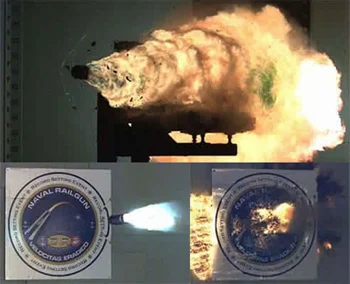For a decade, the U.S. Navy’s electromagnetic railgun was more than a research project; it was a thunderclap from the future. We all saw the videos: a sleek, non-explosive projectile leaving a barrel at speeds that defied imagination—Mach 6, Mach 7—powered by pure, raw electromagnetism. It promised to rewrite the rules of naval warfare, rendering gunpowder obsolete, a relic of a bygone era. The vision was to fire a projectile with the kinetic force of a truck hitting a wall at 160 miles per hour, over and over, from hundreds of miles away.
Then, almost overnight, the thunder went silent.
The program, once a crown jewel of the Office of Naval Research, was quietly shelved. The official reasons trickled out in sterile Pentagon reports: budget headwinds, engineering hurdles, practical challenges. The dream, it seemed, had died, another victim of the brutal gap between a brilliant concept and the unforgiving laws of physics and finance. For a while, that was the end of the story. A magnificent, glorious failure.
But what if failure is just the first draft of success?
A Dream Deferred, Not Destroyed
Let’s be honest about what happened. The American railgun didn’t just fail; it tore itself apart. The immense forces involved—we’re talking about releasing up to 32 megajoules of energy in a hundredth of a second—generated catastrophic heat and stress. To put that in perspective, one megajoule is the energy of a one-ton vehicle moving at 160 mph. The Navy was trying to channel 32 of those through two rails of metal. The result? The barrels would literally crack and erode after fewer than 30 shots. It was like trying to contain lightning in a bottle, and the bottle kept shattering.
This is the kind of engineering problem that gives researchers nightmares. On top of that, the power requirements were simply staggering. Only a ship with a revolutionary power grid, like the Zumwalt-class destroyer, could even hope to generate the 20-30 megawatts needed to charge the capacitors for a single shot. It was a weapon that demanded its own, purpose-built ecosystem.

So, was this a colossal waste of time and money? I don’t think so. Not for a second. This wasn't a failure in the traditional sense; it was the most expensive and valuable physics lesson the Pentagon ever bought. Every cracked barrel, every power surge, every failed test generated priceless data. It’s like the early days of rocketry—you have to blow up a few on the launchpad to learn how to get to the moon. We pushed the boundaries of materials science and pulsed power to their absolute limit, and we found that limit. Was the next step to give up, or to find a way to move that limit?
The Pentagon chose to pivot, salvaging the incredible Hypervelocity Projectile (HVP) and adapting it for use in conventional 5-inch guns and Army howitzers. This was a smart, practical move. The HVP itself is a marvel, a kinetic energy dart traveling at three times the speed of sound without any explosives. But let’s not fool ourselves. It’s the silver medal. It’s a brilliant application of a supporting technology, but it’s not the paradigm shift the railgun itself promised. The real prize—instant, long-range, high-volume kinetic strikes—was left on the table.
The Echo from Across the Pacific
And then, this year, something incredible happened. An echo of that original thunderclap sounded again, this time from the deck of a Japanese test ship, the JS Asuka. The Japan Maritime Self-Defense Force (JMSDF) didn’t just mount a railgun on a ship; news broke that a Japanese Warship Fires Railgun At Target Vessel For The First Time. They took the very dream the U.S. had declared too difficult and brought it back to life.
When I first saw those images, I honestly just sat back in my chair, a huge grin on my face. This wasn't just another country’s weapons test; it was the validation of a revolutionary idea that many had written off. It was proof that the physics was always sound; it was our engineering that hadn't caught up yet.
And the Japanese approach reveals a profound difference in philosophy. Where the U.S. program was a high-stakes sprint for maximum power, Japan’s Acquisition, Technology & Logistics Agency (ATLA) has been running a methodical marathon. Their stated goal from the beginning was a barrel life of 120 rounds. They experimented with different metal alloys and materials until they found a combination that could withstand the strain, confirming that no significant damage occurred even after 120 firings. This is the kind of breakthrough that changes everything—it’s not just about a single weapon, it’s about a whole new class of high-energy systems that suddenly become practical, and it proves the core problem that stalled the U.S. is, in fact, solvable.
They aren't just building a launcher, either. They're developing a complete "gun system," including a fire control system, continuous firing mechanisms, and solutions for stabilizing the projectile in flight. They’re even working with French and German researchers to push the technology forward. What does it say about the nature of innovation when one nation’s perceived dead-end becomes the foundation for another’s breakthrough? It tells us that great ideas don't belong to any one country; they belong to the stubborn, brilliant engineers everywhere who refuse to believe in the impossible.
This Was Never About Just One Gun
The story of the railgun isn't over. It was never just about the U.S. Navy. It’s a global relay race toward a new technological frontier. The United States ran the first leg, pushing hard and fast, and maybe we stumbled, passing on a cracked and overheated baton. But Japan picked it up and is now running a strong second leg, showing everyone it can be done. This isn't a cause for dismay; it's a reason for inspiration. The fundamental physics haven't changed. The promise of electromagnetic launch technology is as real today as it was a decade ago. Now, armed with new materials science data and a clear proof of concept from an ally, the question for the U.S. is no longer if the railgun is possible, but when we’ll have the will to get back in the race.









